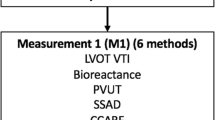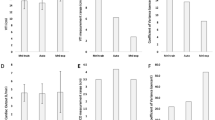Abstract
Non-invasive cardiac output monitoring techniques provide high yield, low risk mechanisms to identify and individually treat shock in the emergency setting. The non-invasive ultrasonic cardiac output monitoring (USCOM) device uses an ultrasound probe applied externally to the chest; however limitations exist with previous validation strategies. This study presents the in vitro validation of the USCOM device against calibrated flow sensors and compares user variability in simulated healthy and septic conditions. A validated mock circulation loop was used to simulate each condition with a range of cardiac outputs (2–10 l/min) and heart rates (50–95 bpm). Three users with varying degrees of experience using the USCOM device measured cardiac output and heart rate by placing the ultrasound probe on the mock aorta. Users were blinded to the condition, heart rate and cardiac output which were randomly generated. Results were reported as linear regression slope (β). All users estimated heart rate in both conditions with reasonable accuracy (β = 0.86–1.01), while cardiac output in the sepsis condition was estimated with great precision (β = 1.03–1.04). Users generally overestimated the cardiac output in the healthy simulation (β = 1.07–1.26) and reported greater difficulty estimating reduced cardiac output compared with higher values. Although there was some variability between users, particularly in the healthy condition (P < 0.01), all estimations were within a clinically acceptable range. In this study the USCOM provided a suitable measurement of cardiac output and heart rate when compared with our in vitro system. It is a promising technique to assist with the identification and treatment of shock.



Similar content being viewed by others
References
Drummond KE, Murphy E. Minimally invasive cardiac output monitors. Contin Educ Anaesth Crit Care Pain. 2011;12(1):5–10.
Bernard S. The patient with shock: Is there any role for the non-invasive monitoring of cardiac output? Emerg Med Australas. 2005;17:189–90.
Meyer S, Todd D, Wright I, Gortner L, Reynolds G. Review article: non-invasive assessment of cardiac output with portable continuous-wave Doppler ultrasound. Emerg Med Australas. 2008;20:201–8.
Rivers E, Nguyen B, Havstad S. Early goal-directed therapy in the treatment of severe sepsis and septic shock. N Engl J Med. 2001;345:1368–77.
Marik PE. Noninvasive cardiac output monitors: a state-of the-art review. J Cardiothorac Vasc Anesth. 2012;27(1):121–34.
Ameloot K, Van De Vijver K, Broch O, et al. Nexfin noninvasive continuous hemodynamic monitoring: validation against continuous pulse contour and intermittent transpulmonary thermodilution derived cardiac output in critically ill patients. Sci World J. 2013;2013:11.
Corley A, Barnett AG, Mullany D, Fraser JF. Nurse-determined assessment of cardiac output. Comparing a non-invasive cardiac output device and pulmonary artery catheter: a prospective observational study. Int J Nurs Stud. 2009;46:1291–7.
Tan HL, Pinder M, Parsons R, Roberts B, van Heerden PV. Clinical evaluation of USCOM ultrasonic cardiac output monitor in cardiac surgical patients in intensive care unit. Br J Anaesth. 2005;94(3):287–91.
Phillips R. Assessment of the clinical utility of an ultrasonic monitor of cardiac output (the USCOM) and agreement with thermodilution measurement. Crit Care Resusc. 2010;12(3):209–13.
Critchley LA, Peng ZY, Fok BS, Lee A, Phillips RA. Testing the reliability of a new ultrasonic cardiac output monitor, the USCOM, by using aortic flowprobes in anesthetized dogs. Anesth Analg. 2005;100(3):748–53.
Thom O, Taylor DM, Wolfe RE, et al. Comparison of a supra-sternal cardiac output monitor (USCOM) with the pulmonary artery catheter. Br J Anaesth. 2009;103(6):800–4.
van Lelyveld-Haas LE, van Zanten AR, Borm GF, Tjan DH. Clinical validation of the non-invasive cardiac output monitor USCOM-1A in critically ill patients. Eur J Anaesthesiol. 2008;25:917–24.
Wong LSG, Yong BH, Young KK, et al. Comparison of the USCOM ultrasound cardiac output monitor with pulmonary artery catheter thermodilution in patients undergoing liver transplantation. Liver Transpl. 2008;14:1038–43.
Lichtenthal PR, Phillips RA, Sloniger JA, Copeland JG. USCOM-non invasive Doppler—are cardiac output measurements accurate in both infants and adults? Anesthesiology. 2006;105:A466.
Alhashemi J, Cecconi M, Hofer C. Cardiac output monitoring: an integrative perspective. Crit Care. 2011;15(2):214.
Gregory SD, Greatrex N, Timms D, Gaddum N, Pearcy MJ, Fraser JF. Simulation and enhancement of a cardiovascular device test rig. J Simul. 2010;4:34–41.
Timms D, Gregory S, Greatrex N, Pearcy MJ, Fraser JF, Steinseifer U. A compact mock circulation loop for the in vitro testing of cardiovascular devices. Artif Organs. 2011;35(4):384–91.
Gregory SD, Stevens M, Timms D, Pearcy M. Replication of the Frank-Starling response in a mock circulation loop. In: Proceedings of the annual international conference of the IEEE Engineering in Medicine and Biology Society, EMBS, Boston, USA; 2011.
Michard F, Teboul JL. Predicting fluid responsiveness in ICU patients—a critical analysis of the evidence. Chest. 2002;121:2000–8.
Maitland K, Kiguli S, Opoka RO, et al. Mortality after fluid bolus in African children with severe infection. N Engl J Med. 2011;364(26):2483–95.
Phillips RA, Hood SG, Jacobson BM, West MJ, Wan L, May CN. Pulmonary artery catheter (PAC) accuracy and efficacy compared with flow probe and transcutaneous Doppler (USCOM): an ovine cardiac output validation. Crit Care Res Pract. 2012;2012. doi:10.1155/2012/621496.
Dark PM, Singer M. The validity of trans-esophageal Doppler ultrasonography as a measure of cardiac output in critically ill adults. Intensive Care Med. 2004;30:2060–6.
Arora D, Chand R, Mehta Y, Trehan N. Cardiac output estimation after off-pump coronary artery bypass: a comparison of two different techniques. Ann Card Anaesth. 2007;10:132–6.
Chand R, Mehta Y, Trehan N. Cardiac output estimation with a new Doppler device after off-pump coronary artery bypass surgery. J Cardiothorac Vasc Anesth. 2006;20:315–9.
Chong SW, Peyton PJ. A meta-analysis of the accuracy and precision of the ultrasonic cardiac output monitor (USCOM). Anaesthesia. 2012;67(11):1266–71.
Chan JS, Segara D, Nair P. Measurement of cardiac output with a non-invasive continuous wave Doppler device versus the pulmonary artery catheter: a comparative study. Crit Care Resusc. 2006;8:309–14.
Dey I, Sprivulis P. Emergency physicians can reliably assess emergency department patient cardiac output using the USCOM continuous wave Doppler cardiac output monitor. Emerg Med Australas. 2005;17:193–9.
Nguyen HB, Losey T, Rasmussen J, et al. Interrater reliability of cardiac output measurements by transcutaneous Doppler ultrasound: implications for noninvasive hemodynamic monitoring in the ED. Am J Emerg Med. 2006;24(7):828–35.
Schnedlitz M. PVC phantoms for photoacoustic methods, In: Photoacoustic Institute, Karl-Franzens University Graz; 2011. p. 42.
Acknowledgments
The authors would like to recognize the financial assistance provided by The Prince Charles Hospital Foundation (SEQ2013-07) and University of Queensland. John F. Fraser acknowledges his fellowship support from the Office of Health and Medical Research, Queensland Health.
Conflict of interest
The authors declare that they have no conflict of interest.
Author information
Authors and Affiliations
Corresponding author
Rights and permissions
About this article
Cite this article
Gregory, S.D., Cooney, H., Diab, S. et al. In vitro evaluation of an ultrasonic cardiac output monitoring (USCOM) device. J Clin Monit Comput 30, 69–75 (2016). https://doi.org/10.1007/s10877-015-9685-8
Received:
Accepted:
Published:
Issue Date:
DOI: https://doi.org/10.1007/s10877-015-9685-8




